- Home
- Forums
- Analog Workflow Forums (100% Analog/Traditional)
- Darkroom
- Silver Gelatin Based Emulsion Making & Coating
You are using an out of date browser. It may not display this or other websites correctly.
You should upgrade or use an alternative browser.
You should upgrade or use an alternative browser.
Experimental Emulsion Lab (old photo)
-
A
- Thread starter Emulsion
- Start date
Recent Classifieds
-
For Sale FS Best TLR ever:) Kodak Brownie Reflex Synchro Model, 127 film
- Started by Erik L
-
For Sale Rodenstock Sironar f 5.6 210 mm lens in Copal 1 shutter
- Started by spoolman
-
For Sale 4x5 film sheaths
- Started by Peter Schrager
-
For Sale 3.25x 4.25 plate holders
- Started by Peter Schrager
-
For Sale Zone vi darkroom safelight
- Started by Peter Schrager
Forum statistics
Photo Engineer
Subscriber
Just an little question of a non English speaker : what is festooning?
I could not find the word in my (Oxford) dictionary...
Philippe
Look at the picture posted on the right above. It shows a 'festoon' of material drying.
PE
Photo Engineer
Subscriber
Ian's post should give you an idea of the size and shape of Kodak equipment. Although this mentions trough and gravure coating, Kodak no longer uses these methods. And, the cabinets are totally enclosed on all machines to control temperature, humidity and to prevent dust and dirt from getting on the wet coating.
That pdf file shows some equipment. Also, there was a previous post that showed an Agfa animation of color coating. I don't have the reference, but I'm sure it can be located here on APUG if you want to see it.
I don't keep these things as I have seen the real thing in action. Sorry.
PE
That pdf file shows some equipment. Also, there was a previous post that showed an Agfa animation of color coating. I don't have the reference, but I'm sure it can be located here on APUG if you want to see it.
I don't keep these things as I have seen the real thing in action. Sorry.
PE
dyetransfer
Member
- Joined
- Jun 18, 2007
- Messages
- 67
- Format
- ULarge Format
Efke coating facility - coating matrix film
Here are some pictures I took at Fotokemika (Efke brand) while we were testing the new emulsion. There are pictures of the trough coater, the drying tunnel (first half) with the coating foreman (on left) and our customer rep. Also shown is the bull wheel which turns the corner, and the wind up station at the end. The drying tunnel is horseshoe shaped going out about 100 feet, around the bull wheel, and back to the windup station (Pictured with myself).
The trough coater picture shows a ultrasonic debubbling device on the wall. The emulsion is pumped through that, into the trough, and it overflows the trough continuously. The roller is lowered to the surface of the emulsion, and the web is started. Pictured is a rubberized cloth leader used for threading the coater. Up above is the chill station, and an over coater used for putting a hardening overcoat on - we didn't use this as the matrix film is unhardened. After that, a few people working on a cat walk gather the loops and attach them to clips on the overhead track. The loops travel slowly out to the the bullwheel, and then back to the windup station. Temperature and humidity are controlled along the way for ideal drying conditions as the film moves along.
I think they told me that the equipment was from Dupont, pre WWII. Fotokemika has a large 'campus' which was very busy during the soviet era, but has been greatly downsized more recently. It was a kick walking down long, long halls in the total darkness, and turning into a side room that you couldn't see which was very dimly lit with red safelights. Sort of like a halloween spook house, but without the suprises.
Also shown is a technician mixing the silver nitrate for the small test we ran, a vacuum filter, a large noodling press, and a sensitizing test. There is also a picture of a small mixer - used for precipitation during small tests such as we were doing. They had much larger temperature controlled mixing vessels. They had tubes running through the gelatin solution which controlled the temperature while precip was happening. They could match the temperature profile that I used while developing the formulation here in the US.
They would coat glass plates frequently while sensitizing, expose them while wet to a test pattern, and process them. They would run into the emulsion engineer's office with film boxes with the processed wet plates, and she would inspect it for a particular type of colored fog which indicated that the ideal sensitizing period had been exceeded.
It was a very interesting experience, and our Croatian hosts were very generous and entertained us by showing us around Zagreb. Samabor is a very nice small town about 1/2 hour out of Zagreb. We made 3 miles of matrix film, all of which has been sold. We had a good level of success partly because the techniques they used in production were similar to the techniques I used while developing the formulation. It translated to production quite well. Lots of dye prints are being made with this film these days.
Regards - Jim Browning
AFAIK, EFKE is the only plant that uses festooning outside of the former Soviet Union. IDK about those within it.
PE
Here are some pictures I took at Fotokemika (Efke brand) while we were testing the new emulsion. There are pictures of the trough coater, the drying tunnel (first half) with the coating foreman (on left) and our customer rep. Also shown is the bull wheel which turns the corner, and the wind up station at the end. The drying tunnel is horseshoe shaped going out about 100 feet, around the bull wheel, and back to the windup station (Pictured with myself).
The trough coater picture shows a ultrasonic debubbling device on the wall. The emulsion is pumped through that, into the trough, and it overflows the trough continuously. The roller is lowered to the surface of the emulsion, and the web is started. Pictured is a rubberized cloth leader used for threading the coater. Up above is the chill station, and an over coater used for putting a hardening overcoat on - we didn't use this as the matrix film is unhardened. After that, a few people working on a cat walk gather the loops and attach them to clips on the overhead track. The loops travel slowly out to the the bullwheel, and then back to the windup station. Temperature and humidity are controlled along the way for ideal drying conditions as the film moves along.
I think they told me that the equipment was from Dupont, pre WWII. Fotokemika has a large 'campus' which was very busy during the soviet era, but has been greatly downsized more recently. It was a kick walking down long, long halls in the total darkness, and turning into a side room that you couldn't see which was very dimly lit with red safelights. Sort of like a halloween spook house, but without the suprises.
Also shown is a technician mixing the silver nitrate for the small test we ran, a vacuum filter, a large noodling press, and a sensitizing test. There is also a picture of a small mixer - used for precipitation during small tests such as we were doing. They had much larger temperature controlled mixing vessels. They had tubes running through the gelatin solution which controlled the temperature while precip was happening. They could match the temperature profile that I used while developing the formulation here in the US.
They would coat glass plates frequently while sensitizing, expose them while wet to a test pattern, and process them. They would run into the emulsion engineer's office with film boxes with the processed wet plates, and she would inspect it for a particular type of colored fog which indicated that the ideal sensitizing period had been exceeded.
It was a very interesting experience, and our Croatian hosts were very generous and entertained us by showing us around Zagreb. Samabor is a very nice small town about 1/2 hour out of Zagreb. We made 3 miles of matrix film, all of which has been sold. We had a good level of success partly because the techniques they used in production were similar to the techniques I used while developing the formulation. It translated to production quite well. Lots of dye prints are being made with this film these days.
Regards - Jim Browning
Attachments
-
 bullwheel.jpg106 KB · Views: 330
bullwheel.jpg106 KB · Views: 330 -
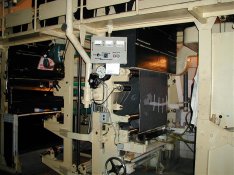 cfk coater1.jpg137 KB · Views: 324
cfk coater1.jpg137 KB · Views: 324 -
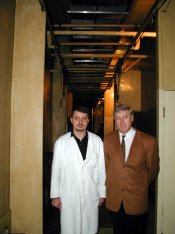 drying tunnel.jpg78 KB · Views: 325
drying tunnel.jpg78 KB · Views: 325 -
 fk coater2.jpg122.9 KB · Views: 342
fk coater2.jpg122.9 KB · Views: 342 -
 mixer.jpg83.7 KB · Views: 315
mixer.jpg83.7 KB · Views: 315 -
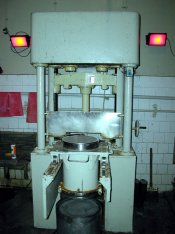 noodle press.jpg89.9 KB · Views: 320
noodle press.jpg89.9 KB · Views: 320 -
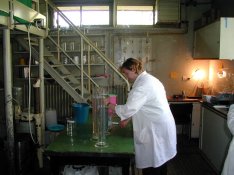 preparing AgN.jpg91.3 KB · Views: 319
preparing AgN.jpg91.3 KB · Views: 319 -
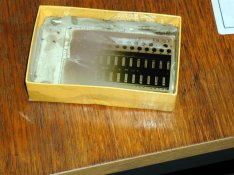 sensitize test.jpg103.2 KB · Views: 334
sensitize test.jpg103.2 KB · Views: 334 -
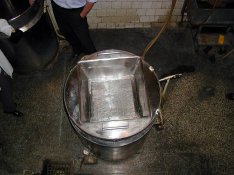 vacuum filter.jpg168.7 KB · Views: 326
vacuum filter.jpg168.7 KB · Views: 326 -
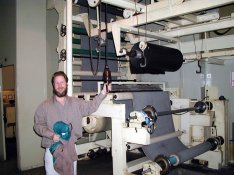 wind up.jpg105.9 KB · Views: 327
wind up.jpg105.9 KB · Views: 327
Ian Grant
Subscriber
Jim, the equipment was definitely the Dupont/Adox plant which was dismantled and shipped from Germany. There's plenty been written about it over the years.
Ian
Ian
Photo Engineer
Subscriber
And I can guarantee that Kodak does not use anything remotely resembling this equipment for making or coating.
It works, but is considered to be antique equimpent which is fully functional.
The post by Ian shows some modern equivalents of this type of equipment, which is still not in any way like Kodak methodology.
PE
It works, but is considered to be antique equimpent which is fully functional.
The post by Ian shows some modern equivalents of this type of equipment, which is still not in any way like Kodak methodology.
PE
Excellent photos and description Jim! Thanks for posting these. Fascinating stuff!
That is very interesting about de-bubbling using ultrasonics. I guess this technique might also be used on a small scale. I have heard of a vacuum (low pressure) being used to de-bubble viscous liquids but not ultrasonics.
Emulsion.
That is very interesting about de-bubbling using ultrasonics. I guess this technique might also be used on a small scale. I have heard of a vacuum (low pressure) being used to de-bubble viscous liquids but not ultrasonics.
Emulsion.
Photo Engineer
Subscriber
Kodak uses a mixture of filtration, vacuum and ultrasonics.
Each lab had a small ultrasonic setup to debubble coating melts prior to use.
PE
Each lab had a small ultrasonic setup to debubble coating melts prior to use.
PE
| Photrio.com contains affiliate links to products. We may receive a commission for purchases made through these links. To read our full affiliate disclosure statement please click Here. |
PHOTRIO PARTNERS EQUALLY FUNDING OUR COMMUNITY:  |









